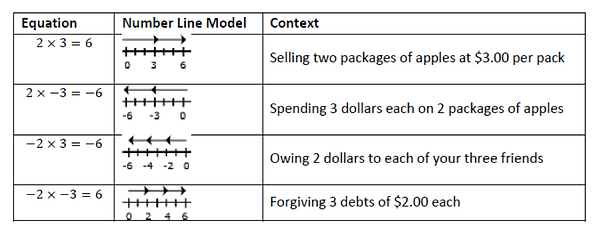SEVENTH GRADE > 7.NS.2 > TEACHER GUIDE

TEACHER GUIDE TO CLARIFICATION
7.NS.2
7.NS.2 Apply and extend previous understandings of multiplication and division and of fractions to multiply and divide rational numbers.
a) Understand that multiplication is extended from fractions to rational numbers by requiring that operations continue to satisfy the properties of operations, particularly the distributive property, leading to products such as (-1)(-1) = 1 and the rules for multiplying signed numbers. Interpret products of rational numbers by describing real-world contexts.
b) Understand that integers can be divided, provided that the divisor is not zero, and every quotient of integers (with non- zero divisor) is a rational number. If p and q are integers, then -(p/q) = (-p)/q = p/(-q). Interpret quotients of rational
numbers by describing real-world contexts.
c) Apply properties of operations as strategies to multiply and divide rational numbers.
d) Convert a rational number to a decimal using long division; know that the decimal form of a rational number terminates in 0s or eventually repeats.
Multiply and Divide Rational Numbers
This standard wants students to truly explore the properties of operations when multiplying and dividing rational numbers and integers. Integer rules that were once given to students to follow should be discovered by the students. They will gain a deeper knowledge and be able to apply this knowledge to solving algebraic equations.

Integer rules that were once given to students to follow should be discovered by the students. Allow them to explore the signs and what they really mean.
7.NS.2 Major topics
-
Multiplying a negative by a positive whole number
-
The importance of Distributive Property to explain why
-
Understanding the relationship between addition and subtraction of rational numbers
-
Understanding the relationship between multiplication and division of rational numbers
-
Making sense of fractions and negative integers
-
Complex fractions
From the Progression Document Number Sense:
Multiplication and division of rational numbers
Hitherto (previously) we have been able to come up with visual models to represent rational numbers, and the operations of addition and subtraction on them. This starts to break down with multiplication and division, and students must rely increasingly on the properties of operations to build the necessary bridges from their previous understandings to situations where one or more of the numbers might be negative.
For example, multiplication of a negative number by a positive whole number can still be understood as before;
-
just as 5 x 2 can be understood as 2 + 2 + 2 + 2 + 2 = 10,
-
so 5 x -2 can be understood as (-2) x (-2) x (-2) x (-2) x (-2) = 10
We think of 5 x 2 as five jumps to the right on the number line, starting at 0, and we think of 5 x (-2) as five jumps to the left.

We need students to think about direction on the number line vs. rules
But what about x -2, or -5 x -2? Perhaps the former can be understood as going of the way from 0 to -2, that is . For the latter, teachers sometimes come up with metaphors involving going backwards in time or repaying debts. But in the end these metaphors do not explain why -5 x -2 = 10. In fact, this is a choice we make, not something we can justify by appeals to real world situations.

Why does
-5 x -2 equal positive 10?
Why do we make the choice of saying that a negative times a negative is positive? Because we want to extend the operation of multiplication to rational number in such a way that all of the properties of operations are satisfied.
7.NS.2a In particular, the property that really makes a difference here is the distributive property. If you want to be able to say that
4 x (5 + (-2)) = 4 x 5 + 4 x (-2)
Then you have to say that 4 x (-2) = -8 because the number on the left is 12 and the first addend on the right is 20. This leads to the rules;
positive x negative = negative and negative x positive = negative
If you want to be able to say that
(-4) x (5 + (-2)) = (-4) x 5 + (-4) x (-2)
Then you have to say that (-4) x (-2) = 8 since now we know that the number on the left is -12 and the first addend on the right is -20. This leads to the rule
negative x negative = positive

Use of the distributive property explains why integer rules work. Allow students to discover.
Why is it important to maintain the distributive property? Because when students get to algebra, they use it all the time. They must be able to say -3x – 6y=- 3( x + 2y) without worrying about whether x and y are positive or negative.
The rules about moving negative signs around in a product result from the rules about multiplying negative and positive numbers. Think about the various possibilities for p and q in
p x (-q) = (-p) x q = -pq
If p and q are both positive, then this is just a restatement of the rules above. But it still works if, for example, p is negative and q is positive. In that case is says
negative x negative = positive x positive = positive
Just as the relationship between addition and subtraction helps students understand subtraction of rational numbers, so the relationship between multiplication and division helps them understand division.
To calculate -8 ÷ 4, students recall that (-2) x 4 = -8, and so -8 ÷ 4 = -2. By the same reasoning,

Important for students to know how to rewrite these equations with the sign moving around and to reason why it makes sense
This means it makes sense to write
Until this point students have not seen fractions where the numerator or denominator could be a negative integer. But working with the corresponding multiplication equations allows students to make sense of such fractions. In general, they see that7.NS.2b
For any integers p and q, with q ≠ 0.
Again, using multiplication as a guide, students can extend division to rational numbers that are not integers.7.NS.2c For example
And again it makes sense to write this division as a fraction:
Note that this is an extension of the fraction notation to a situation it was not originally designed for. There is no sense in which we can think of
as parts where one part is obtained by dividing the line segment from 0 to 1 into equal parts! But the fact that the properties of operations extend to rational numbers means that calculations with fractions extend to these so-called complex fractions , where p and q could be rational numbers, not only integers. By the end of Grade 7, students are solving problems involving complex fractions. 7.NS.3
Common Core Standards Writing Team. (2013, July 4).
Progressions for the Common Core State Standards in Mathematics (draft). Grades 6–8, The Number System; High School, Number. Tucson, AZ: Institute for Mathematics and Education, University of Arizona.
7.NS.1c-1
7.NS.2c
Apply and extend previous understandings of addition and subtraction to add and subtract rational numbers; represent addition and subtraction on a horizontal or vertical number line diagram.
c. Understand subtraction of rational numbers as adding the additive inverse, p – q = p + (–q). Apply this principle in real-world contexts.
Apply and extend previous understandings of multiplication and division and of fractions to multiply and divide rational numbers.
c. Apply properties of operations as strategies to multiply and divide rational numbers.
i) Tasks may or may not have a context.
ii) Tasks are not limited to integers.
iii) Contextual tasks might, for example, require students to create or identify a situation described by a specific equation of the general form p – q = p + (–q) such as 3 – 5 = 3 + (–5).
iv) Non-contextual tasks are not computation tasks but rather require students to demonstrate conceptual understanding, for example, by identifying a difference that is equivalent to a given difference. For example, given the difference −1/3 − (1/5 + 5/8), the student might be asked to recognize the equivalent expression –1/3 + –(1/5 + 5/8).
i) Tasks do not have a context.
ii) Tasks are not limited to integers.
iii) Tasks may involve products and quotients of 2 or 3 rational numbers.
iv) Tasks require students to compute a product or quotient, or demonstrate conceptual understanding, for example, by producing or recognizing an expression equivalent to a given expression. For example, given the expression (−8)(6)/( −3), the student might be asked to recognize or produce the equivalent expression −(8/3)( −6).

When looking at the IAR Evidence Tables, the clarification statements make clear how students’ conceptual knowledge of the properties of operations will be assessed. Students will need to recognize or produce an expression using distributive property. This skill is different than how students were assessed in the past.
Illinois Assessment of Readiness Mathematics Evidence Tables https://www.isbe.net/Documents/IAR-Grade-7-Math-Evidence-State.pdf
Explanations and Examples:
Students recognize that when division of rational numbers is represented with a fraction bar, each number can have a negative sign. Using long division from elementary school, students understand the difference between terminating and repeating decimals. This understanding is foundational for work with rational and irrational numbers in 8th grade. For example, identify which fractions will terminate (the denominator of the fraction in reduced form only has factors of 2 and/or 5.)
Multiplication and division of integers is an extension of multiplication and division of whole numbers.
Examples
Examine the family of equations. What pattern do you see?
Create a model and context for each of the products.
Write and model the family of equations related to 2 × 3 = 6.

Instructional Strategies:
Instruction needs to focus on developing understanding of operations with rational numbers. Students need multiple opportunities to develop a unified understanding of number,
-
recognizing fractions
-
decimals (that have a finite or repeating decimal representation)
-
percent as different representations of rational numbers.

Notice this standard is not just focusing on whole numbers but all numbers.
Students extend addition, subtraction, multiplication, and division to all rational numbers, maintaining the properties of operations and the relationships between addition and subtraction, and multiplication and division. By applying these properties, and by viewing negative numbers in terms of everyday contexts (e.g. amounts owed or temperatures below zero), students explain and interpret the rules for “operating” with negative numbers. In Grade 7 the awareness of rational and irrational numbers is initiated by observing the result of changing fractions to decimals. Students should be provided with families of fractions, such as, sevenths, ninths, thirds, etc. to convert to decimals using long division. The equivalents can be grouped and named (terminating or repeating). Students should begin to see why these patterns occur. Knowing the formal vocabulary rational and irrational is not expected.
Kansas Association of Teachers of Mathematics (KATM) Flipbooks. Questions or to send feedback: melisa@ksu.edu.
Retrieved from Math Flipbooks.

Methods to discuss integer rules with complex fractions
Coherence and Connections: Need to Know
Grade Below
Grade Level
Grade Above
5.NF.4
6.NS.1
7.NS.1
7.NS.2
7.NS.3
8.NS.1
Fluency Expectations or Examples of Culminating Standards
7.NS.1–2 Adding, subtracting, multiplying, and dividing rational numbers is the culmination of numerical work with the four basic operations. The number system will continue to develop in grade 8, expanding to become the real numbers by the introduction of irrational numbers, and will develop further in high school, expanding to become the complex numbers with the introduction of imaginary numbers. Because there are no specific standards for rational number arithmetic in later grades and because so much other work in grade 7 depends on rational number arithmetic (see below), fluency with rational number arithmetic should be the goal in grade 7.
Examples of Major Within-Grade Dependencies
Meeting standard 7.EE.3 in its entirety will involve using rational number arithmetic (7.NS.1–3) and percents (7.RP.3). Work leading to meeting this standard could be organized as a recurring activity that tracks the students’ ongoing acquisition of new skills in rational number arithmetic and percents.
Because rational number arithmetic (7.NS.1–3) underlies the problem solving detailed in 7.EE.3 as well as the solution of linear expressions and equations (7.EE.1–2, 4), this work should likely begin at or near the start of the year.
The work leading to meeting standards 7.EE.1–4 could be divided into two phases, one centered on addition and subtraction (e.g., solving x + q = r) in relation to rational number addition and subtraction (7.NS.1) and another centered on multiplication and division (e.g., solving px + q = r and p(x + q) = r) in relation to rational number multiplication and division (7.NS.2).
Examples of Opportunities for In-Depth Focus
7.NS.3 When students work toward meeting this standard (which is closely connected to 7.NS.1 and 7.NS.2), they consolidate their skill and understanding of addition, subtraction, multiplication and division of rational numbers.
PARCC Model Content Frameworks: Mathematics Grades 3-11 (version 5). (2017, November).
Retrieved from https://files.eric.ed.gov/fulltext/ED582070.pdf
Illinois Assessment of Readiness Mathematics Evidence Tables. Retrieved from:
https://www.isbe.net/Documents/IAR-Grade-7-Math-Evidence-State.pdf
Evidence
Statement Key
Evidence Statement Text
Clarifications
MP
7.NS.2a-1
Apply and extend previous understandings of multiplication and division and of fractions to multiply and divide rational numbers.
a. Understand that multiplication is extended from fractions to rational numbers by requiring that operations continue to satisfy the properties of operations, particularly the distributive property, leading to products such as (–1)(–1) = 1 and the rules for multiplying signed numbers.
7
Calculator
no
i) Tasks do not have a context.
ii) Tasks require students to demonstrate conceptual understanding, for example by providing students with a numerical expression and requiring students to produce or recognize an equivalent expression using properties of operations. For example, given the expression (−3)(6 + −4 + −3), the student might be asked to recognize that the given expression is equivalent to (−3)(6 + −4) + (−3)(−3)
7.NS.2a-2
2,4
no
7.NS.2b-1
Apply and extend previous understandings of multiplication and division and of fractions to multiply and divide rational numbers.
b. Understand that integers can be divided, provided that the divisor is not zero, and every quotient of integers (with non-zero divisor) is a rational number. If p and q are integers, then -(p/q) = (–p)/q =p/(–q).
i) Tasks do not have a context.
ii) Tasks require students to demonstrate conceptual understanding, for example, by providing students with a numerical expression and requiring students to produce or recognize an equivalent expression.
7
no
7.NS.2b-2
Apply and extend previous understandings of multiplication and division and of fractions to multiply and divide rational numbers.
c. Interpret quotients of rational numbers by describing real-world contexts
2,4
no
7.NS.2c
Apply and extend previous understandings of multiplication and division and of fractions to multiply and divide rational numbers.
c. Apply properties of operations as strategies to multiply and divide rational numbers.
i) Tasks do not have a context.
ii) Tasks are not limited to integers.
iii) Tasks may involve products and quotients of 2 or 3 rational numbers. iv) Tasks require students to compute a product or quotient, or demonstrate conceptual understanding, for example, by producing or recognizing an expression equivalent to a given expression. For example, given the expression (−8)(6)/( −3), the student might be asked to recognize or produce the equivalent expression −(8/3)( −6).
no
7
7.C.1.1
Base explanations/reasoning on the properties of operations. Content Scope: Knowledge and skills articulated in 7.NS.1 and 7.NS.2
i) Tasks should not require students to identify or name properties.
1,2,3,5,6,7
yes
7.C.2
Base explanations/reasoning on the relationship between addition and subtraction or the relationship between multiplication and division. Content Scope: Knowledge and skills articulated in 7.NS.1 and 7.NS.2
Base explanations/reasoning on a number line diagram (whether provided in the prompt or constructed by the student in her response). Content Scope: Knowledge and skills articulated in 7.NS.A
1,2,3,5,6,7
yes
7.C.3
1,2,3,5,6,7
yes
7.C.7.2
Present solutions to multi-step problems in the form of valid chains of reasoning, using symbols such as equals signs appropriately (for example, rubrics award less than full credit for the presence of nonsense statements such as 1 + 4 = 5 + 7 = 12, even if the final answer is correct), or identify or describe errors in solutions to multi-step problems and present corrected solutions.
Content Scope: Knowledge and skills articulated in 7.NS.2d
i) Tasks focus on demonstrating understanding that a number is rational.
ii) Tasks do not directly assess the ability to divide two whole numbers.
Base explanations/reasoning on a number line diagram (whether provided in the prompt or constructed by the student in her response). Content Scope: Knowledge and skills articulated in 7.NS.A
1,3,6,7,8
yes
Apply and extend previous understandings of multiplication and division and of fractions to multiply and divide rational numbers.
a. Interpret products of rational numbers by describing real-world contexts
Also check out Student Achievement Partners Coherence Map.
HOT Questions
1. Mrs. Maze was checking papers. Different answers are given by each student. Who is correct?
* Joey answered
* Ally answered
* Arron answered
* David answered -0.75
* Kathy answered
2. Create a word problem using the quotient
3. Find the equivalent expression, select all that apply.

4. Which equation is equivalent to
3. I would like to make a gravel path to my garden. The path is 10 ft long by 2 ft wide. The gravel should be about 2 inches
thick. Gravel costs $15.00 per cubic foot. How much will it cost to create my gravel path way?
a) -30 x 4 = x
b) -30 ÷ 4 = x
c) -1 ÷ (28 ÷ 4) = x
d) -1 ÷ (28 x 4) = x
Additional Resources
Illustrative Mathematics
http://tasks.illustrativemathematics.org/content-standards/7/NS/A/2/tasks/593
http://tasks.illustrativemathematics.org/content-standards/7/NS/A/2/tasks/604
http://tasks.illustrativemathematics.org/content-standards/7/NS/A/2/tasks/1541
http://tasks.illustrativemathematics.org/content-standards/7/NS/A/2/tasks/1542
http://tasks.illustrativemathematics.org/content-standards/7/NS/A/2/tasks/1602
http://tasks.illustrativemathematics.org/content-standards/7/NS/A/2/tasks/1667
http://tasks.illustrativemathematics.org/content-standards/7/NS/A/2/tasks/1986
http://tasks.illustrativemathematics.org/content-standards/7/NS/A/2/tasks/2041
Inside Mathematics- Performance Tasks
https://www.insidemathematics.org/sites/default/files/materials/cat%20food_2.pdf
https://www.insidemathematics.org/sites/default/files/materials/cereal_4.pdf
IL Classrooms in Action - Formative Assessment
http://www.mathteachersinaction.org/formative-assessment-tasks.html
Achieve the Core
https://achievethecore.org/page/1057/decimal-expansion-of-fractions
Using Positive and Negative Numbers in Context
http://map.mathshell.org/materials/lessons.php?taskid=453&subpage=concept
